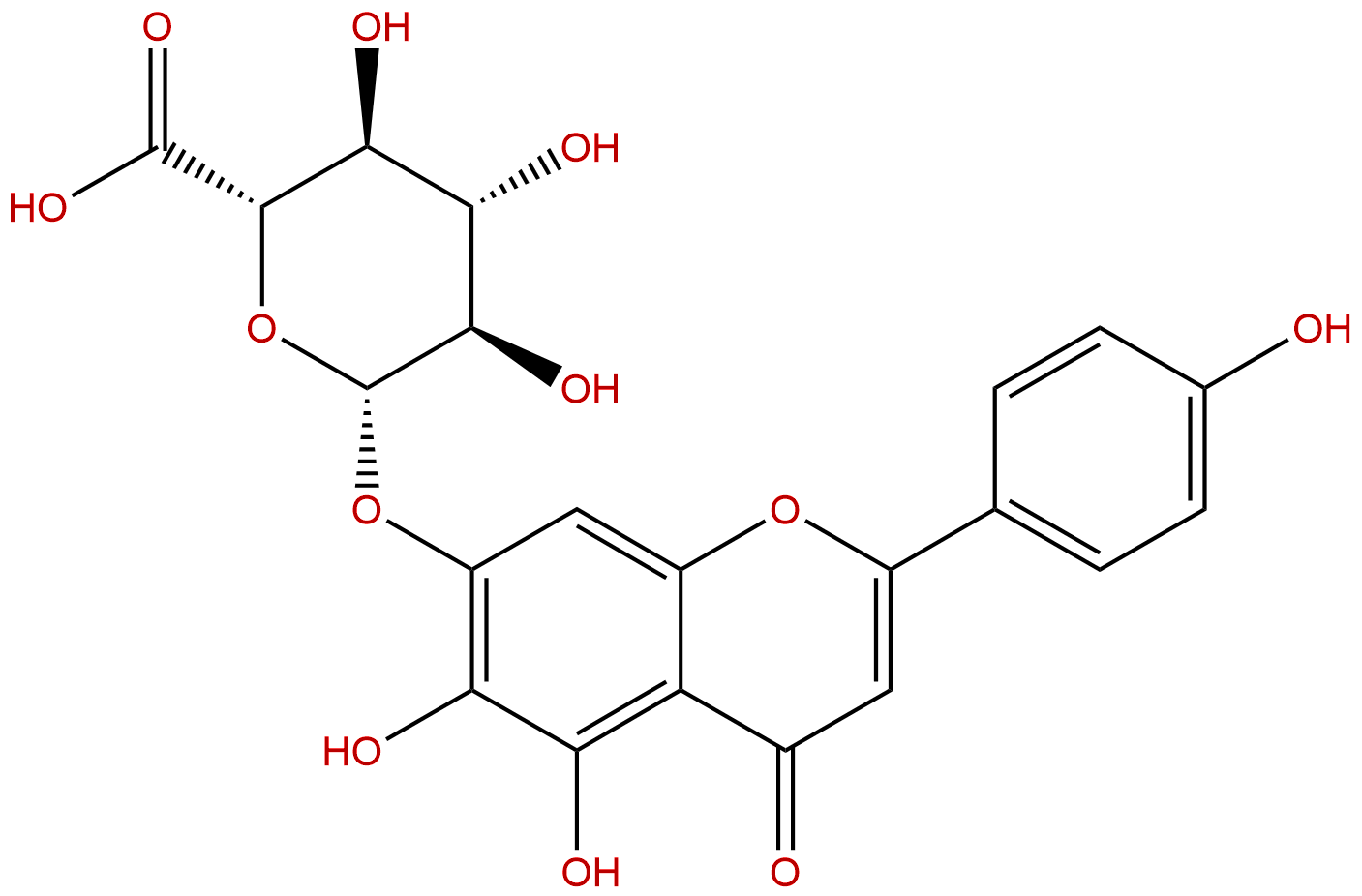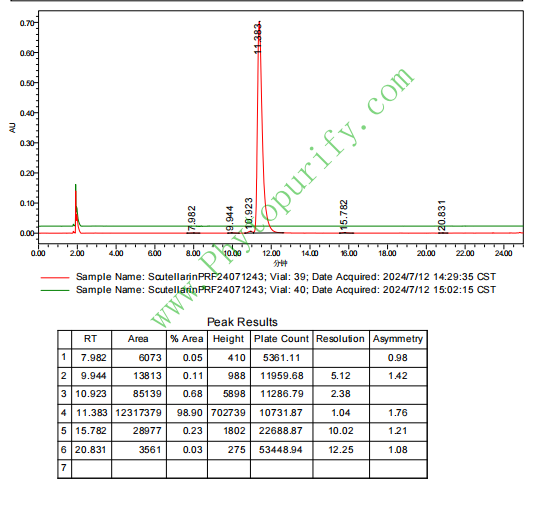
ScutellarinCAS No.:27740-01-8
|
||||||||||
 |
|
|
||||||||

| Catalogue No.: | BP1278 |
| Formula: | C21H18O12 |
| Mol Weight: | 462.363 |
Product name: Scutellarin
Synonym name:
Catalogue No.: BP1278
Cas No.: 27740-01-8
Formula: C21H18O12
Mol Weight: 462.363
Botanical Source: Erigerontis herba
Physical Description:
Type of Compound: Flavonoids
Purity: 95%~99%
Analysis Method: HPLC-DAD or/and HPLC-ELSD
Identification Method: Mass, NMR
Packing: Brown vial or HDPE plastic bottle
The product could be supplied from milligrams to grams
Inquire for bulk scale.
Description:
Scutellarin has many pharmacological effects, such as antioxidant, antitumor, antiviral, neuroprotection and antiinflammatory activities. It down-regulates the STAT3/Girdin/Akt signaling in HCC cells, and inhibits RANKL-mediated MAPK and NF-κB signaling pathway in osteoclasts.
References:
Life Sci. 2004 Apr 30;74(24):2959-73.
Protection against hydrogen peroxide-induced cytotoxicity in PC12 cells by scutellarin.
The present study investigated the protective actions of the antioxidant Scutellarin against the cytotoxicity produced by exposure to H2O2 in PC12 cells. This was done by assaying for MTT (3,(4,5-dimethylthiazole-2-yl)2,5-diphenyl-tetrazolium bromide) reduction and lactate dehydrogenase (LDH) release.
METHODS AND RESULTS:
Reactive oxygen species (ROS) and Ca2+ in cells were evaluated by fluorescent microplate reader using DCFH and Fura 2-AM, respectively, as probes. Lipid peroxidation was quantified using thiobarbituric acid-reactive substances (TBARS). Mitochondrial membrane potential (MMP) was assessed by the retention of rhodamine123 (Rh123), a specific fluorescent cationic dye that is readily sequestered by active mitochondria, depending on their transmembrane potential. The DNA content and percentage of apoptosis were monitored with flow cytometry. Vitamin E, a potent antioxidant, was employed as a comparative agent. Preincubation of PC12 cells with Scutellarin prevented cytotoxicity induced by H2O2. Intracellular accumulation of ROS, Ca2+ and products of lipid peroxidation, resulting from H2O2 were significantly reduced by Scutellarin. Incubation of cells with H2O2 caused a marked decrease in MMP, which was significantly inhibited by Scutellarin. PC12 cells treated with H2O2 underwent apoptotic death as determined by flow cytometric assay. The percentage of this H2O2-induced apoptosis in the cells was decreased in the presence of different concentrations of Scutellarin. Scutellarin exhibited significantly higher potency compared to the antioxidant vitamin E.
CONCLUSIONS:
The present findings showed that Scutellarin attenuated H2O2-induced cytotoxicity, intracellular accumulation of ROS and Ca2+, lipid peroxidation, and loss of MMP and DNA, which may represent the cellular mechanisms for its neuroprotective action.
Br J Pharmacol. 2011 Feb;162(3):688-700.
Scutellarin alleviates interstitial fibrosis and cardiac dysfunction of infarct rats by inhibiting TGFβ1 expression and activation of p38-MAPK and ERK1/2.
Interstitial fibrosis plays a causal role in the development of heart failure after chronic myocardial infarction (MI), and anti-fibrotic therapy represents a promising strategy to mitigate this pathological process. The purpose of this study was to investigate the effect of long-term administration of Scutellarin (Scu) on cardiac interstitial fibrosis of myocardial infarct rats and the underlying mechanisms.
METHODS AND RESULTS:
Scu was administered to rats that were subjected to coronary artery ligation. Eight weeks later, its effects on cardiac fibrosis were assessed by examining cardiac function and histology. The number and collagen content of cultured cardiac fibroblasts exposed to angiotensin II (Ang II) were determined after the administration of Scu in vitro. Protein expression was detected by Western blot technique, and mRNA levels by quantitative reverse transcription-PCR. The echocardiographic and haemodynamic measurements showed that Scu improved the impaired cardiac function of infarct rats and decreased interstitial fibrosis. Scu inhibited the expression of FN1 and TGFβ1, but produced no effects on inflammatory cytokines (TNFα, IL-1β and IL-6) in the 8 week infarct hearts. Scu inhibited the proliferation and collagen production of cardiac fibroblasts (CFs) and the up-regulation of FN1 and TGFβ1 induced by Ang II. The enhanced phosphorylation of p38-MAPK and ERK1/2 in both infarct cardiac tissue and cultured CFs challenged by Ang II were suppressed by Scu.
CONCLUSIONS:
Long-term administration of Scu improved the cardiac function of MI rats by inhibiting interstitial fibrosis, and the mechanisms may involve the suppression of pro-fibrotic cytokine TGFβ1 expression and inhibition of p38 MAPK and ERK1/2 phosphorylation.
HPLC of Scutellarin
